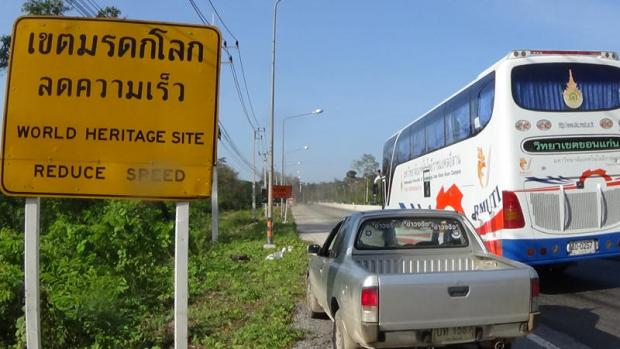
A section of Highway 304 which divides part of the world-renowned Dong Phayayen-Khao Yai forest complex and is notorious for deadly accidents, is being given a new look more friendly to wildlife and motorists.
The Highways Department has started counting down to Dec 8 this year when the road reconstruction will be finished, rejoining the forest's divided areas and, at the same time, making the park safer for motorists.
Officials believe their new road design with a mix of an underpass, two flyovers and more traffic lanes can overcome transport problems and settle disputes with environmental advocates, who have voiced concerns over animals' safety when they cross the highway.
One incident occurred in 2015 when a gaur was hit by a car as it was crossing the road to drink water at a nearby canal at Huai Sap Bon in the Dong Phayayen-Khao Yai forest complex.
Environmentalists also raised questions over the "wildlife corridor" the department earlier planned to build as a crossing, or viaduct, for the animals because they were worried about its environmental impact, not to mention whether wildlife would actually use the man-made structure.
There will be no wildlife crossing and the animals will be able to walk around more easily with the new road design, according to Phonwanlop Chanpraphatson, an engineer overseeing the Highway 304 upgrade project, which covers a section of the road from Nakhon Ratchasima's Pak Thong Chai district to Prachin Buri's Kabin Buri district.
An underpass and two flyovers will be built on parts of the road section where wild animals usually cross between its two sides, he said.
Motorists will drive through a 430-metre tunnel under the road which will be filled and surfaced with soil to allow for animals to cross, Mr Phonwanlop said.
At another part, two flyovers, each with two traffic lanes, will be built in parallel eight metres above the ground over a distance of 570 metres. Cars will be able to travel on the elevated roads while animals can walk underneath, he said.
With this management plan, the Highways Department believes the wild animals won't be disturbed by passing cars as much.
The construction is part of a 1.3-billion-baht deal the department has signed with Italian-Thai Development Plc. Under the contract, the company will also build a 2.41-kilometre road with fences along certain parts, Mr Phongwanlop said.
Two other contracts, worth 1.5 billion baht in total, have been inked with two firms to increase the number of traffic lanes from two to four over 15.5km.
The traffic lane expansion is considered important by the department because Highway 304 before it enters the forest is wide, with four lanes. The road then narrows in mountainous areas, causing difficulties to motorists given the many curves and steep slopes, making accidents common.
Last year, a double-decker coach plunged off the narrow road in the dark at a curve while it was travelling downhill on this section of the highway. The accident killed two students and four teachers and left 44 others injured.
Highway 304 divided Dong Phayayen-Khao Yai forest complex, which was designated by the United Nations Educational, Scientific and Cultural Organisation (Unesco) as a world natural heritage site in 2005. New construction projects in the area are therefore a very sensitive issue.
Unesco's World Heritage Committee expressed concern in 2012 when it learned Thai authorities planned to expand the highway as this would increase the number of cars entering the forest complex. Though the expansion would be outside the protected area, it could still lead to more traffic inside the World Heritage site, former chief of National Parks, Wildlife and Plant Conservation Department, Damrong Pidech, said earlier.
However, Mr Phongwanlop said he believed the new design of this section of the highway should prevent any negative impacts on the environment.
The newly reconstructed highway would support the economy and the tourism industry while ensuring that Dong Phayayen-Khao Yai forest complex is maintained as a "treasure for people in Thailand and around the world", he said.

A photo shows the new road design with a mix of an underpass, two flyovers and traffic lane expansion.

Two flyovers are being built on parts of Highway 304 which wild animals also will be able to walk under.

A traffic sign asks motorists on Highway 304 to reduce speed when they enter the world-renowned Dong Phayayen-Khao Yai forest complex. photos by Manit Sannubboon